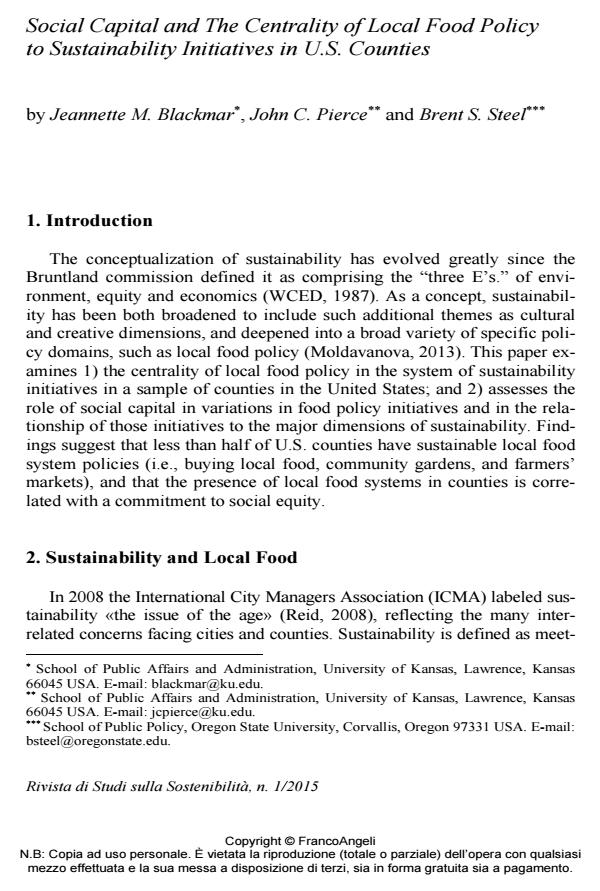Social Capital and The Centrality of Local Food Policy to Sustainability Initiatives in U.S. Counties
Journal title RIVISTA DI STUDI SULLA SOSTENIBILITA'
Author/s Jeannette M. Blackmar, John C. Pierce, Brent S. Steel
Publishing Year 2015 Issue 2015/1
Language Italian Pages 18 P. 45-62 File size 252 KB
DOI 10.3280/RISS2015-001004
DOI is like a bar code for intellectual property: to have more infomation
click here
Below, you can see the article first page
If you want to buy this article in PDF format, you can do it, following the instructions to buy download credits

FrancoAngeli is member of Publishers International Linking Association, Inc (PILA), a not-for-profit association which run the CrossRef service enabling links to and from online scholarly content.
The conceptualization of sustainability has evolved greatly since the Bruntland commission defined it as comprising the "three E’s." of environment, equity and economics (WCED, 1987). As a concept, sustainability has been both broadened to include such additional themes as cultural and creative dimensions, and deepened into a broad variety of specific policy domains, such as local food policy (Moldavanova, 2013). This paper examines 1) the centrality of local food policy in the system of sustainability initiatives in a sample of counties in the United States; and 2) assesses the role of social capital in variations in food policy initiatives and in the relationship of those initiatives to the major dimensions of sustainability.
La concettualizzazione della sostenibilita si e evoluta notevolmente da quando la commissione Brundtland l’ha definita come comprendente le "tre E", dell’ambiente, dell’equita e dell’economia (WCED, 1987). Il concetto di sostenibilita e stato sia ampliato per includere temi supplementari, come le dimensioni culturali e creative, che approfondito in una vasta gamma di settori specifici, come la politica alimentare locale (Moldavanova, 2013). Questo articolo esamina 1) la centralita della politica alimentare locale nel sistema di iniziative di sostenibilita in un campione di contee degli Stati Uniti; e 2) valuta il ruolo del capitale sociale nelle variazioni di iniziative politiche alimentare e nel rapporto di queste iniziative alle maggiori dimensioni della sostenibilita.
Keywords: Local food policy, sustainability initiatives, social capital, U.S. counties, local food systems, farmers’ markets.
Jeannette M. Blackmar, John C. Pierce, Brent S. Steel, Social Capital and The Centrality of Local Food Policy to Sustainability Initiatives in U.S. Counties in "RIVISTA DI STUDI SULLA SOSTENIBILITA'" 1/2015, pp 45-62, DOI: 10.3280/RISS2015-001004